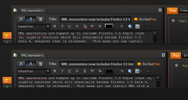
If you already have NNL installed, this update will be available through the usual automatic Firefox theme update method, or you can install it manually from AMO.

 further betas of 3.5 (if there are any) and then 3.5 itself.
further betas of 3.5 (if there are any) and then 3.5 itself.Launch controllers spotted the bat after it had clawed onto the foam of the external tank as Discovery stood at Launch Pad 39A. The temperature never dropped below 60 degrees at that part of the tank, and infrared cameras showed that the bat was 70 degrees through launch.
 Firefox 3.1 Beta 3 is now out -- users who want to help test this not-yet-complete application can download it here.
Firefox 3.1 Beta 3 is now out -- users who want to help test this not-yet-complete application can download it here. in Florida. Once in position, the Kepler instrument will spend the next three-plus years staring intently at a very small patch of sky (containing tens of thousands of suns) looking for Earth-sized planets. We've already found some 300 larger, gas-giant-sized planets using Hubble and ground-based telescopes. Kepler increases the resolution of the search.
in Florida. Once in position, the Kepler instrument will spend the next three-plus years staring intently at a very small patch of sky (containing tens of thousands of suns) looking for Earth-sized planets. We've already found some 300 larger, gas-giant-sized planets using Hubble and ground-based telescopes. Kepler increases the resolution of the search.